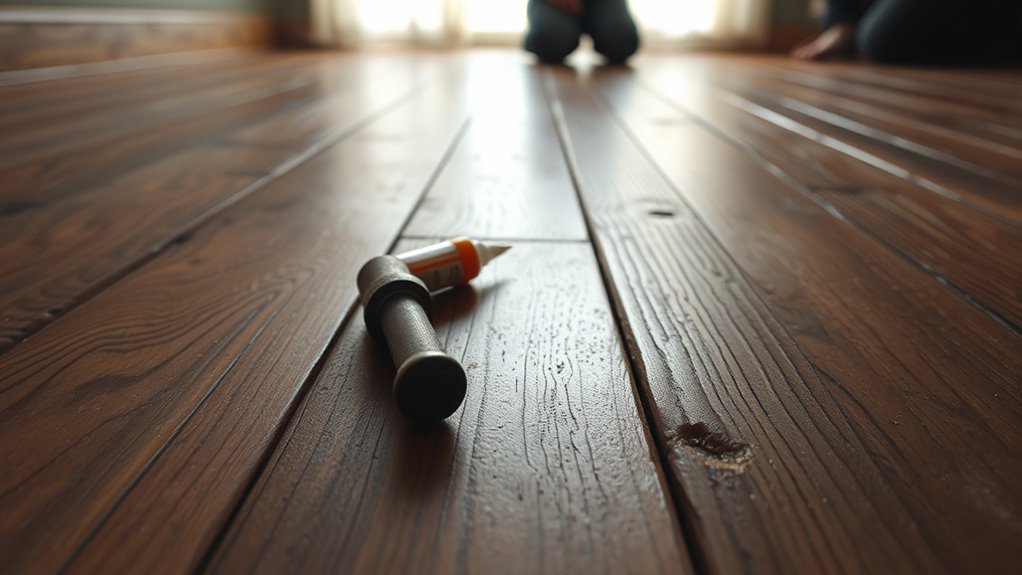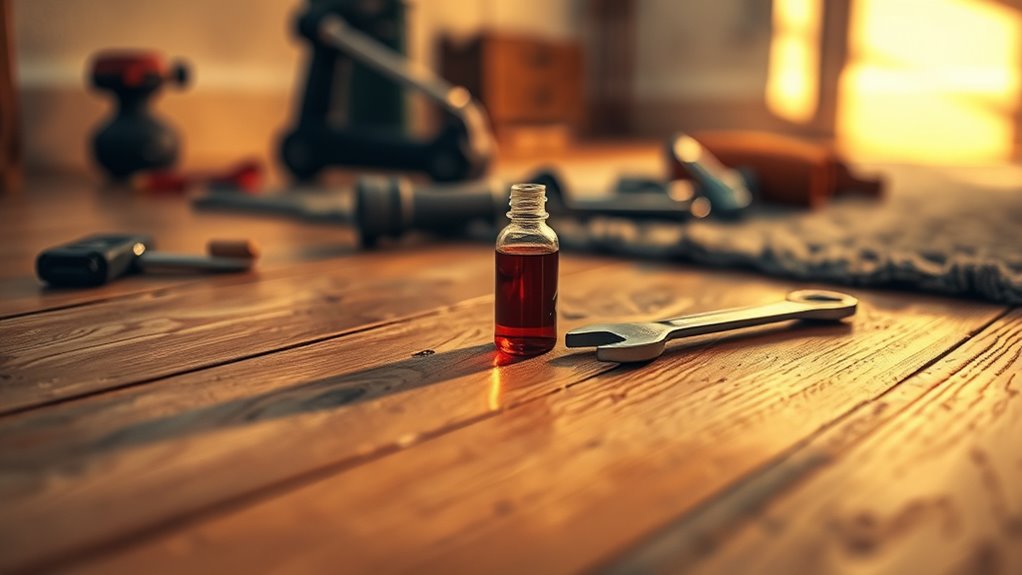To fix squeaky floors quickly, start by identifying the source of the squeak. Walk on the floor while listening from below to pinpoint the area. For a quick fix, use lubricants like powdered graphite or talcum powder in the gaps. You can also drive screws into the subfloor for a more permanent solution, but be sure to drill pilot holes to prevent splitting. If you want to explore comprehensive repair methods, there’s more to learn.
Key Takeaways
- Use lubricants like powdered graphite or talcum powder in gaps for an immediate but temporary noise reduction.
- Drive screws into the subfloor to firmly secure it to the joists, eliminating movement that causes squeaks.
- Apply construction adhesive to strengthen the bond between the subfloor and joists for a more permanent fix.
- Employ a Squeeeeek-No-More Kit for quick repairs in carpeted areas without removing the carpet.
- Regularly check and tighten any loose fasteners in high-traffic areas to prevent future squeaks.

Squeaky floors can be more than just an annoyance; they often signal underlying issues like loose hardware or gaps between the joists and subfloor. If you’re tired of the noise whenever you walk across your hardwood floors, it’s time to take action.
Fortunately, fixing squeaky floors isn’t as daunting as it may seem. With a bit of effort and the right materials, you can silence those pesky creaks and groans.
First, you’ll want to identify the source of the squeak. It often helps to have a friend walk on the floor while you listen closely from below. As they walk, listen for movement that indicates where the squeak originates. Once you pinpoint the area, you can proceed with repairs.
A common method to fix squeaky floors is to drive screws into the subfloor. These screws secure the subfloor to the joists beneath, effectively reducing friction that causes the noise. When using screws, it’s a good idea to drill pilot holes first to prevent splitting the wood.
If you discover gaps between the joists and subfloor, shims can be a quick and effective solution. You can slide shims into these gaps, which helps stabilize the floor and further reduce any movement that leads to squeaking.
Additionally, applying construction adhesive during installation or repairs can provide long-lasting benefits. This adhesive creates a strong bond that helps prevent future squeaks from developing.
For carpeted areas, the Squeeeeek-No-More Kit is an innovative tool that allows you to fix squeaky floors without removing the carpet. This kit enables you to drive breakaway screws through the carpet, securing the subfloor to the joists beneath. It’s a neat solution that saves you from the hassle of lifting heavy carpets.
In some cases, you might consider lubricants like powdered graphite to help reduce friction temporarily. However, while these can work in a pinch, they’re usually more of a short-term fix.
The most effective way to ensure your floor repair is permanent is to address the root cause by tightening loose fasteners and securing everything properly.
Frequently Asked Questions
What Is the Easiest Way to Fix Squeaky Floors?
The easiest way to fix squeaky floors is to first pinpoint the source of the noise.
Have someone walk on the floor while you listen from below for movement or loose nails.
Once you identify the problem, you can apply powdered graphite lubricant between floorboards to reduce friction.
If that doesn’t work, consider using shims to fill gaps or driving screws from above to secure the subfloor to the joists.
Does WD-40 Work on Squeaky Floors?
Yes, WD-40 can work on squeaky floors, but it’s more of a temporary fix.
It lubricates the friction points, reducing the noise for a while. However, it doesn’t penetrate well for wood-to-wood contact and can leave a greasy residue that attracts dust.
For a longer-lasting solution, you might want to consider alternatives like powdered graphite or talcum powder, which are better suited for hardwood floor squeaks.
Just make sure to clean the area first!
Why Does My Floor Creak When I Walk on It?
Your floor creaks when you walk on it due to loose floorboards rubbing against each other or nails in the subfloor. This friction creates the annoying sound you hear with every step.
As your home ages, materials settle and warp, increasing gaps and movement that lead to those creaks. Environmental factors like humidity can also cause wood to expand and contract, contributing to the noise.
It’s a common issue, especially in older homes.
What Is the Best Lubricant for Squeaky Floors?
You’d think your floorboards would appreciate your weight, but instead, they squeak like they’re auditioning for a musical!
For the best lubricant, you can’t go wrong with powdered graphite. It slides right into those annoying gaps without leaving a mess. Just sprinkle it between the boards, and step on it to work it in.
Talcum powder works too, but graphite’s your go-to for a long-lasting, squeak-free dance floor.
Conclusion
In conclusion, tackling squeaky floors doesn’t have to be a daunting task. With a few simple tools and techniques, you can silence those annoying creaks and enhance your home’s comfort. After all, who wouldn’t want to walk across their floors without the constant reminder of their age? So, roll up your sleeves, follow the steps outlined, and enjoy the satisfaction of a quieter, more peaceful living space. Your floors—and your peace of mind—will thank you!









